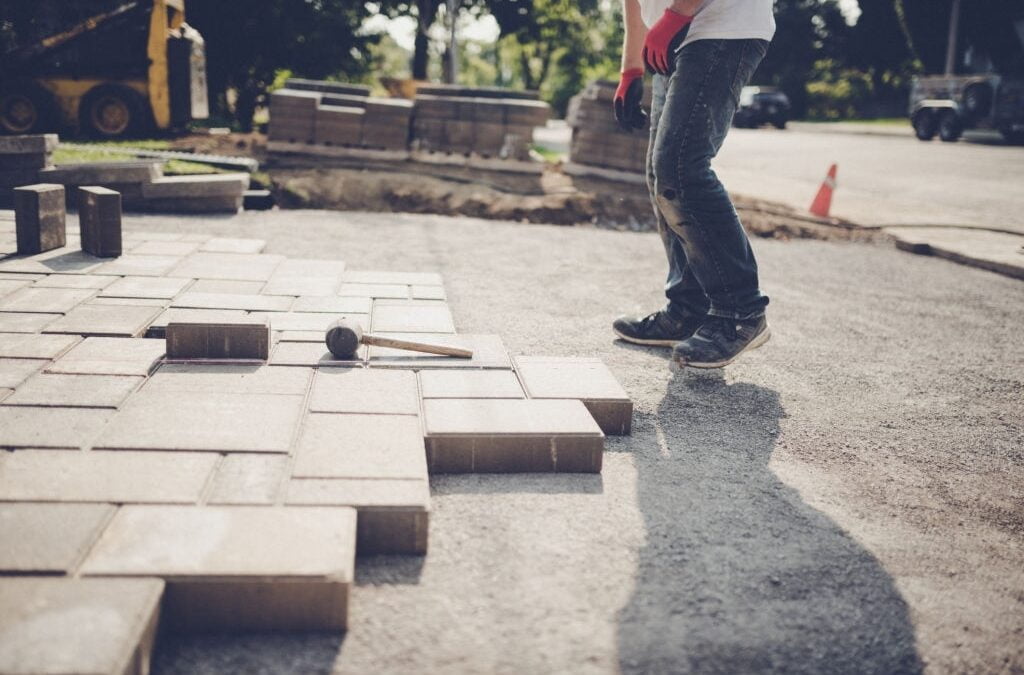Stamped concrete is a popular option for homeowners and builders who want to add a unique and stylish touch to their indoor and outdoor spaces. But what exactly is stamped concrete? In simple terms, it is a concrete surface stamped with various patterns and textures to resemble other materials such as wood, stone, or brick.
Stamping concrete involves pouring the concrete mixture onto a prepared surface and using specialized stamps to create the desired pattern and texture. The stamps are typically made of rubber or polyurethane and are pressed into the concrete while it is wet. Once the concrete has cured, it is sealed to protect it from damage and to enhance its appearance.
The Process of Stamping Concrete
Now you’ll see how we take plain concrete and turn it into a work of art by stamping it with intricate designs and textures. Stamping concrete involves creating a mold or template of the desired design, placing it onto the wet concrete, and pressing it down firmly. This creates an impression of the design on the surface of the concrete.
Once the design is stamped onto the concrete, it is left to dry and cure for some time. During this time, the concrete will harden and become more durable. Once fully cured, the concrete can be stained or colored to enhance the design and make it more visually appealing. The result is a beautiful, unique surface that adds aesthetic and functional value to any property.
Benefits of Stamped Concrete for Indoor and Outdoor Use
If you’re looking for a versatile and durable option for your indoor or outdoor space, you’ll love the benefits of using stamped concrete. One of the biggest benefits of stamped concrete is its ability to mimic the look of other materials, such as brick, stone, or even wood. This means you can achieve the aesthetic you want without paying the high price tag associated with those materials.
In addition to its versatility, stamped concrete is also incredibly durable. It can withstand heavy foot traffic, weather conditions, and even vehicular traffic, making it a great option for driveways and other high-traffic areas. Plus, it requires very little maintenance, making it an easy choice for those who want a beautiful, long-lasting surface without constant upkeep. Overall, the benefits of stamped concrete make it a smart choice for anyone looking to improve their indoor or outdoor space.
Maintenance and Care for Stamped Concrete Surfaces
Taking care of your newly installed stamped concrete surface is easy and requires minimal effort. The first thing you need to do is to make sure that the surface is clean at all times. Sweeping or blowing away any debris or dust that may accumulate on the surface is important to prevent any scratches or damage. Use a pressure washer to clean the surface periodically, but use a low-pressure setting to avoid damaging the stamped design.
In addition to regular cleaning, it is also important to seal the stamped concrete surface every few years to protect it from moisture and other elements. A high-quality sealant will protect the surface and enhance the stamped design’s color and texture. If you notice any cracks or damage, it is important to repair them immediately to prevent further damage. Following these simple maintenance tips ensures that your stamped concrete surface will look great for years.
Transform Your Space
Transform your indoor and outdoor spaces with the stunning, customizable look of stamped concrete from Gatlinbyrd Cement. As an experienced concrete company, we specialize in creating beautiful, durable stamped concrete surfaces that mimic the appearance of brick, stone, wood, and more. Our skilled concrete contractors will work with you to design a unique stamped concrete solution tailored to your style and needs, whether it’s for a new driveway, patio, or indoor flooring. Contact Gatlinbyrd Cement today to learn more about our concrete services and how we can elevate the aesthetic and functionality of your property.
Contact Us Now
Frequently Asked Questions
How does the cost of stamped concrete compare to other materials like natural stone or brick?
Stamped concrete typically costs less than high-end pavers and natural stone because it requires less labor and materials. While exact costs vary depending on the region and the complexity of the project, stamped concrete usually offers a significant cost saving while still providing a similar aesthetic.
What are some common patterns and finishes available with stamped concrete?
Popular patterns for stamped concrete include cobblestone, slate, flagstone, tile, and wood grain. Finishes can range from colored stains and antiqued effects to glossy sealers that highlight the depth and texture of the stamping.
Can stamped concrete be used in driveways?
Yes, stamped concrete is durable enough for driveways and can withstand the weight of vehicles when properly installed and maintained. It's a popular choice for driveways because it combines long-lasting durability with aesthetic appeal.
What maintenance is required for stamped concrete surfaces?
Stamped concrete requires minimal maintenance. Regular cleaning and periodic resealing every few years will protect the surface from wear and fading. It's important to promptly repair any small cracks or chips to maintain its appearance and durability.
Is stamped concrete slippery when wet?
Stamped concrete can be slippery when wet, especially if sealed with a high-gloss sealer. However, anti-slip additives can be mixed into the sealer to enhance traction without detracting from the appearance.
How long does stamped concrete last?
With proper installation and maintenance, stamped concrete can last for decades. Its lifespan can be comparable to that of traditional pavers or natural stone when it's properly sealed and cared for.
Can stamped concrete be installed over an existing concrete surface?
Stamped concrete overlays can be applied over existing concrete surfaces, provided the existing concrete is in good condition. This can be a cost-effective way to upgrade the look of a patio, walkway, or driveway without a complete replacement.

